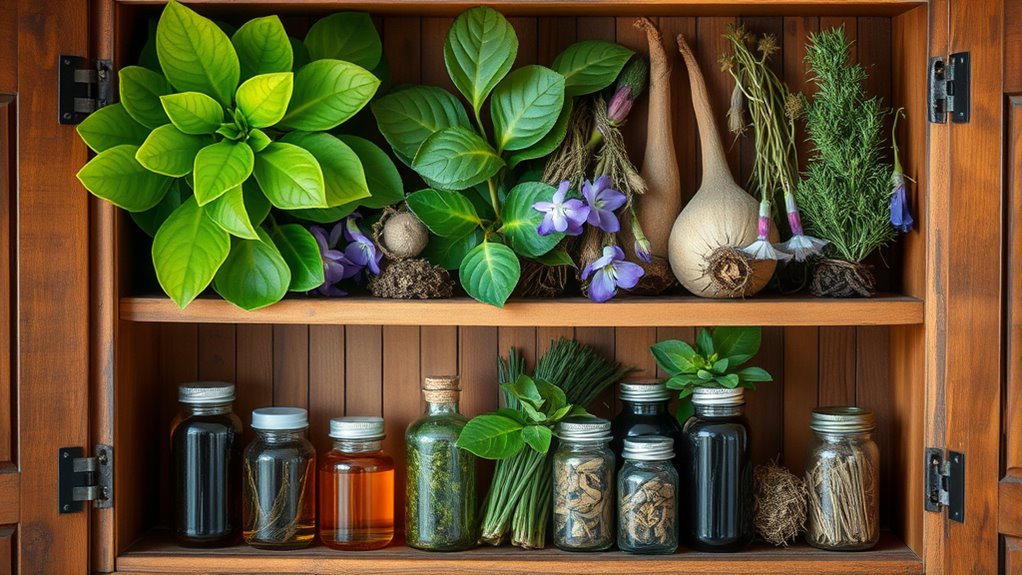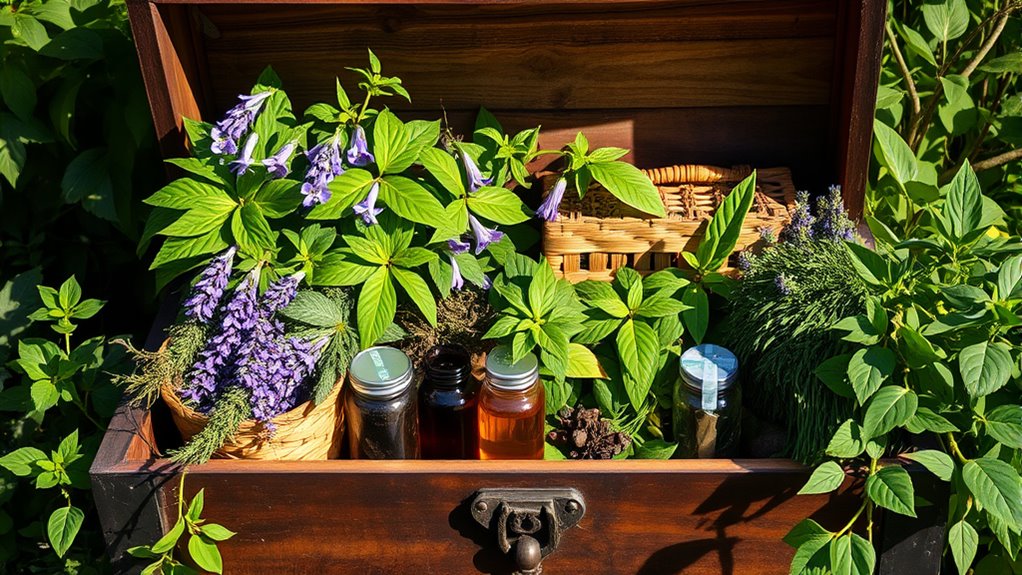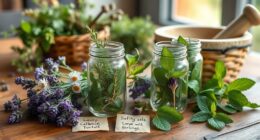A three-plant medicine chest for wild remedies includes options like arnica for pain relief, echinacea to boost immunity and combat infections, and nettle to reduce allergy symptoms. These plants can be prepared using simple herbal extraction methods, such as tinctures, teas, or infusions, to access their medicinal properties. With these versatile herbs, you can address common health issues naturally and confidently. Keep exploring to learn how to create powerful, effective remedies from these tried-and-true plants.
Key Takeaways
- A three-plant medicine chest typically includes arnica for pain relief, echinacea for infections, and nettle for allergies.
- Herbal extraction methods like tinctures and infusions preserve plant properties for effective remedies.
- Arnica can be prepared as topical tinctures or ointments to reduce swelling and soothe muscles externally.
- Echinacea is used as a tincture or tea to boost immunity and fight early infections.
- Nettle teas or tinctures help alleviate allergy symptoms by reducing inflammation and nasal congestion.

A well-stocked medicine chest can be a lifesaver, especially when it contains the right plants for common ailments. When you’re exploring natural remedies, understanding herbal extraction is key. Herbal extraction involves drawing out the active compounds from plants, whether through infusion, decoction, tinctures, or oils. This process helps preserve the plant’s medicinal properties, making it easier for you to use them effectively. Many traditional usages of these plants have been passed down through generations, and they serve as the foundation for modern herbal medicine. Knowing how to prepare and apply these remedies can turn your medicine chest into a powerful toolkit for managing pain, fighting infection, and alleviating allergies. Utilizing proper storage methods, such as vetted indoor planters, can help maintain the potency of your herbal preparations over time.
A well-stocked herbal kit with traditional extraction methods can effectively treat pain, infection, and allergies naturally.
For pain relief, one of the most reliable plants is arnica. Traditionally, arnica has been used externally to reduce swelling and soothe muscle soreness. Its traditional usage involves creating topical ointments or tinctures that you can apply directly to the affected area. The herbal extraction process here is simple—steeping arnica flowers in alcohol to produce a tincture that retains its anti-inflammatory properties. When applied correctly, arnica can help ease bruises, sprains, and muscle pain. Remember, though, that arnica should never be ingested in large amounts, as it can be toxic if misused. Its traditional use, combined with proper herbal extraction techniques, makes it a valuable addition to your herbal medicine chest.
Infections are another common concern you can address with natural remedies. One such plant is echinacea. Its traditional usage spans centuries, especially among indigenous peoples, who used it to boost immunity and fight off colds and infections. When you prepare echinacea, you typically use herbal extraction methods like making tinctures or teas from the roots or flowers. These preparations concentrate the active compounds that stimulate your immune system. Consuming echinacea at the first sign of infection can help shorten your illness and support your body’s defenses. Its long-standing traditional usage and the ease of herbal extraction make echinacea a dependable remedy for infection prevention and management.
Lastly, for allergies, nettle stands out. Traditionally, nettle has been used to reduce allergic symptoms like hay fever and nasal congestion. The traditional usage involves making teas or tinctures from dried leaves. Herbal extraction ensures you capture the plant’s anti-inflammatory and antihistamine properties, which can help ease allergy symptoms. Drinking nettle tea or taking tinctures regularly during allergy season can provide relief without the side effects often associated with conventional medications. Plus, knowing how to properly prepare and extract nettle makes it a practical addition to your natural medicine chest. With the right plants and extraction techniques rooted in traditional usage, you can confidently address pain, infection, and allergies with wild remedies.
Frequently Asked Questions
How Do I Identify These Wild Plants Safely?
To identify wild plants safely, you should focus on accurate plant identification and foraging safety. Always consult reliable field guides, join local foraging groups, or take a workshop to learn key features like leaf shape, flower structure, and habitat. Never consume a plant unless you’re 100% sure of its identity, and be cautious of look-alikes. Remember, proper identification is essential to avoid poisonous or harmful plants.
Are There Any Side Effects From Using These Remedies?
You might worry about side effects, but knowing about plant toxicity and allergic reactions helps. While most wild remedies are safe when used properly, some plants can cause allergic reactions or toxicity if misused. Always start with small doses and observe your reactions. Consulting an expert or reliable guide reduces risks. Remember, even natural remedies can have side effects, so stay cautious and informed.
Can I Use These Plants Alongside Conventional Medicine?
You can often use these plants alongside conventional medicine, but you should be cautious. Some plants may cause herb-drug interactions or plant toxicity, leading to unwanted side effects. Always consult your healthcare provider before combining herbal remedies with prescribed treatments. They can help you assess potential risks, ensuring safe use and avoiding adverse herb-drug interactions or toxicity that could complicate your health.
How Should I Store and Preserve These Wild Remedies?
Imagine your wild remedies as treasures from nature’s secret vault. To keep them potent, focus on proper plant harvesting at peak freshness, then dry or tincture your herbs promptly. Store these herbal preservation methods in airtight, dark containers away from sunlight and humidity. This way, your remedies stay effective, vibrant, and ready to serve whenever you need them, ensuring their healing power endures through time.
What Legal Considerations Exist for Foraging Wild Plants?
When foraging wild plants, you need to consider legal factors like obtaining harvesting permits if required in your area. Always ensure accurate plant identification to avoid dangerous look-alikes and potential legal issues. Respect private property and protected lands, and avoid overharvesting to preserve ecosystems. Staying informed about local regulations and properly identifying plants helps you forage safely and legally, ensuring your wild remedies are both effective and compliant with the law.
Conclusion
Think of your three-plant medicine chest as a trusty toolbox, ready to tackle common ailments. Once, a friend relied on these remedies during a stubborn infection, and it cleared up faster than she expected. Just like a well-stocked drawer, having these plants on hand means you’re prepared for pain, infection, or allergies anytime they arise. Trust in nature’s pharmacy—your simple, powerful first aid kit for life’s surprises.










